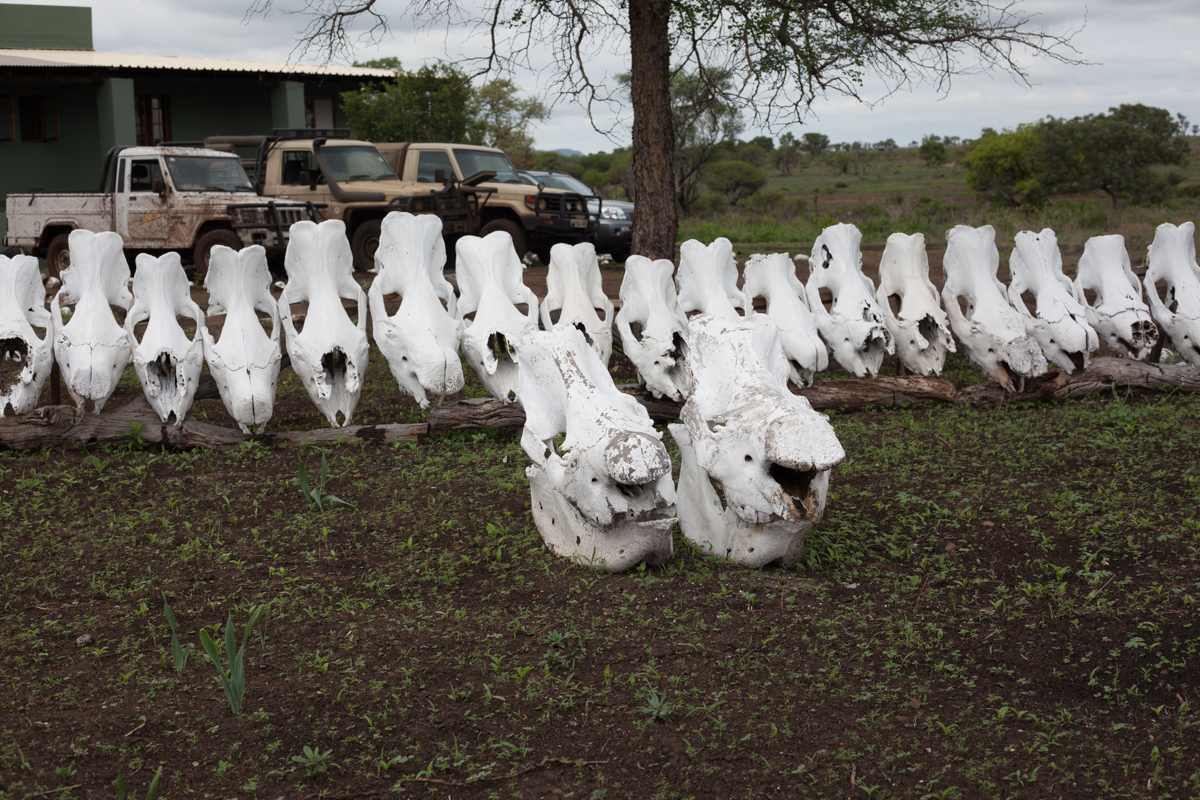
01 Jun The uphill battle to save rhinos in Mozambique
American photojournalist Martin Totland travelled to the borderlands between Mozambique and Kruger National Park to investigate the latest in the anti-poaching war
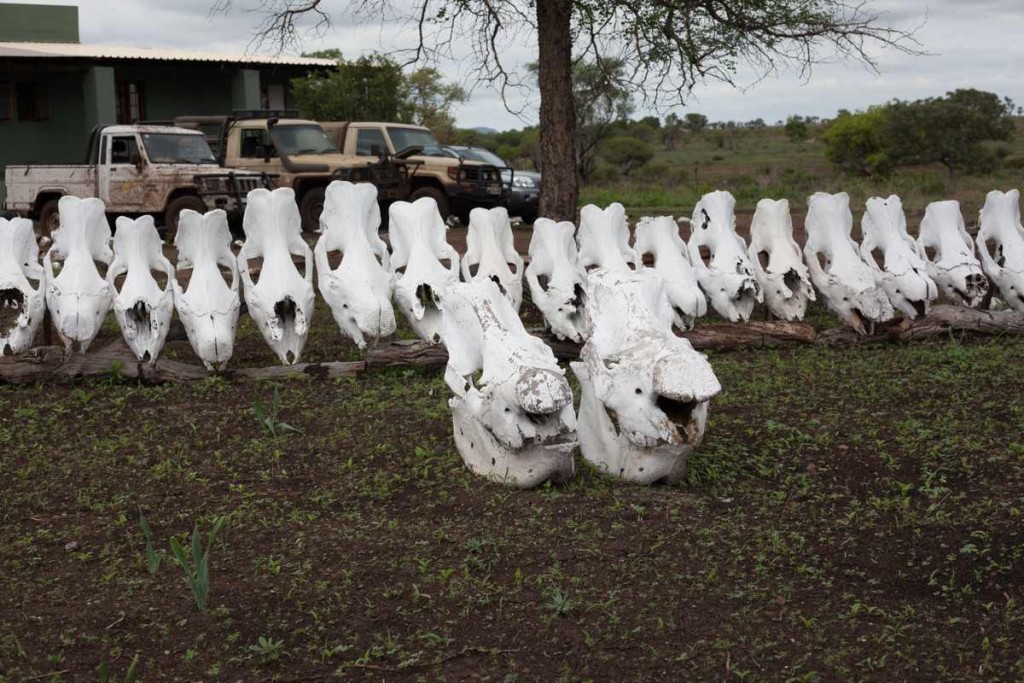
A row of rhino skulls inside Sabie Game Park. The two in front died natural deaths, the ones at the back lost their lives to poachers. Photos by Martin Totland
It was widely reported in 2013 that poachers had killed Mozambique’s last rhino. The good news: it wasn’t true. The bad news: it will very likely soon become true.
It is an open secret among conservationists that Mozambique still has some rhinos left. They wander the 30,000ha property of Sabie Game Park, a privately owned game reserve in the south-western part of the country.
The park straddles the border with South Africa and its world-famous Kruger National Park, where nearly 80% of the world’s remaining rhinos live. This area is the frontline of the rhino war and if you ask those involved, the future’s not looking too bright.
Like many others, I saw the news stories and I kept noticing people in the comment sections cheering whenever stories emerged of rangers killing poachers. People applauded rangers for killing people in a fight over a useless commodity. Poachers were called evil monsters, and rangers were called heroes. This two-dimensional image didn’t seem right.
In March, police seized 23 rhino horns and other illegal wildlife artefacts at Maputo International Airport but made no arrests. During April and May, Mozambican law enforcement agencies carried out nationwide seizures of more than 900 pieces of rhino horn, and arrested one suspect. Officials said they hoped the suspect would lead them to a criminal syndicate behind the poaching.
On May 2, a Vietnamese citizen was arrested at the Maputo airport with two suitcases crammed with 11 whole rhino horns and several horn segments. And on May 14, photos emerged online of yet another rhino slain in Mozambique, its missing horn very likely being prepared for transport out of the country.
I went to Mozambique to find out more about why so many Mozambicans enter a trade that costs so many of their lives, what’s driving a charismatic species closer to extinction, and what the future looks like. I decided to go to the frontlines to gain a better understanding.
In Mozambique I met a group of guys with more than a decade of combined experience in the conservation and anti-poaching world. They aren’t rangers, park managers, or government officials.
Because of the dangers inherent to pursuing ruthless criminal syndicates and taking their money away, I have to protect the real identities of the men I interviewed and spent time with in Mozambique. If they were to be identified, that information could be used against them, and lives could be lost.
Since 2013 they have gathered information about Mozambique’s poaching economy and its major players. They use this information and cooperate with law enforcement agencies to pursue mid-level players in the international rhino horn trade.
Think of it like this: the people who poach rhinos are at the bottom rung of a vast shadow economy. Even if you arrest 100 of them a week, more will replace them, drawn by the promise of big money, a daring adventure and, perhaps most importantly, the chance to feed their family.
The leader of the team refers to the bottom-level poachers as “cannon fodder.” While that might sound cruel, it’s not wrong: South African park rangers killed more than 500 poachers between 2010 and 2015, according to news reports.
Trying to eliminate the “cannon fodder” is a waste of time, so the team sets their sights on the next two rungs in the poaching hierarchy: the local crime bosses who finance the poaching, supply the firearms, and sell the horn; and the people who arrange for transport of horns to Asia. By intervening at these levels, the team hopes to remove the economic incentives motivating the bottom-rung poachers, forcing them to find better ways to make money.
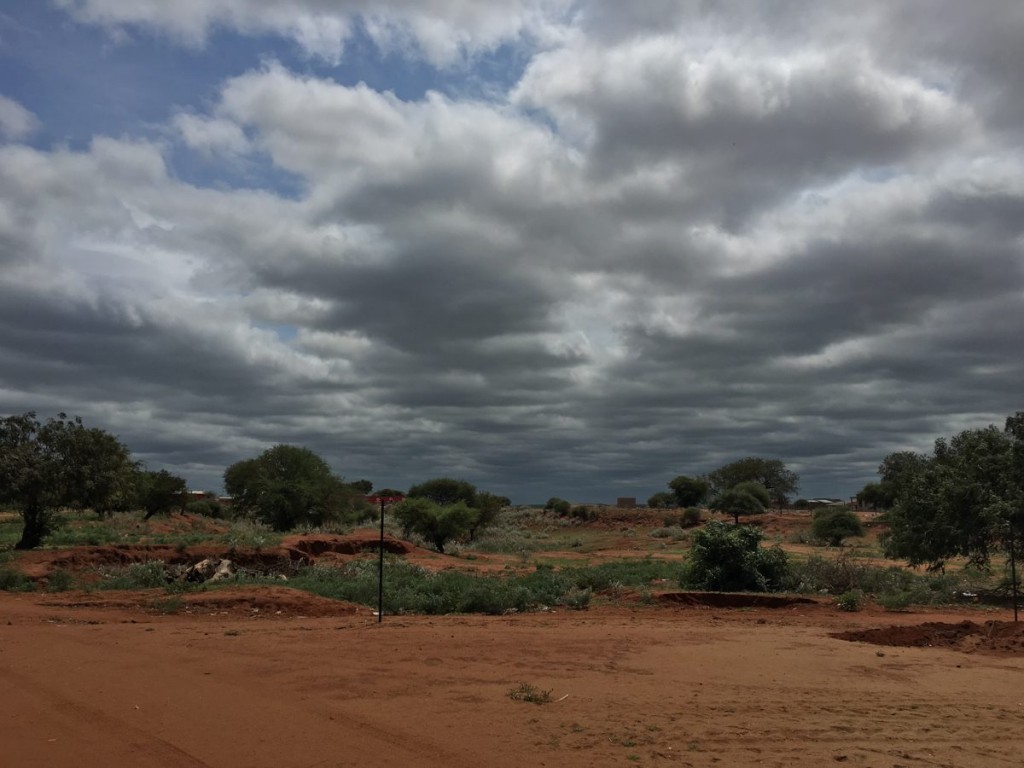
Massingir is the rhino poaching capital of Mozambique. Despite the illicit wealth pouring into the community, it has very little development
Poaching capital
I got to see how this works on a trip to Massingir with a team member. Massingir, a growing town in Gaza province situated about 10km east of Kruger National Park, is considered the poaching capital of Mozambique. Nearly 80% of people in the town are involved, either directly or indirectly. If you spend enough time here you will inevitably meet some of them.
One of team’s older sources introduced us to a new one, and we spent the day together. If you want people in a town like Massingir to be your friend and talk to you, there is only one reliable course of action, which is drinking. So that is what we did.
The new source was clearly nervous, avoided eye contact, and said almost nothing. We bought him food and beer, made jokes, drove him around town, and were very friendly and helpful. When we drove him home at night he was still nervous, but thanked us for the ride as he left.
We couldn’t expect him to tell us everything he knew, but the first brick of groundwork had been laid: we got to know him, and started earning his trust. Recruiting sources is a long game that cannot be rushed. A few weeks after my visit, the team member returned to Massingir with a colleague and continued the work.
If a source provides reliable information on a suspect, it is analysed and handed over to a prosecutor, who decides if it’s above board and passes it on to the police. This cooperation between law enforcement agencies in Mozambique is slowly making an impact.

Sunrise over Sabie Game Park, seen from the anti-poaching plane. The park is 30,000ha of wilderness, through which poachers often try to pass to enter the Kruger National Park
On the ground
As a contrast, I moved on to spend time with a traditional anti-poaching outfit based at Sabie Game Park, which borders the Kruger park in the south. I wanted to get a better understanding of the underlying factors that motivate poachers from this outfit, the International Anti-Poaching Foundation (IAPF).
At Sabie, managing the park is divided between the park’s staff and the IAPF, an independent organisation that operates there. The staff tracks animals and cares for wildlife and visitors, while the IAPF protects the remaining rhinos from poachers.
Every day rangers patrol the park, but because of its vast size and their limited personnel, they have to be strategic about where they focus their efforts. For instance, they routinely check the areas close to the border fence with the Kruger since they’re more likely to find poachers there.
I joined the IAPF rangers on a daily hike through the bush and found several signs of intruders through the day. First, in a dense stretch of bush we found a small cave used to stash weapons. The opening had been partially closed off, with stacked rocks carefully placed to hide things inside. Normally it would be used for weapons, but this time there was nothing inside.
Later, we found several backpacks, clothes and food tins left behind, only a few minutes from the border. They were left in the shade of a big tree on a hill, a strategic hiding spot for poachers needing a place to rest before entering Kruger. Interestingly, we also found a jug of muti, a potion made by local witch doctors. Poachers believe that drinking it makes them invisible to park rangers.
The IAPF rangers collect all such items and take them to their headquarters for analysis, in case they turn up any useful clues.
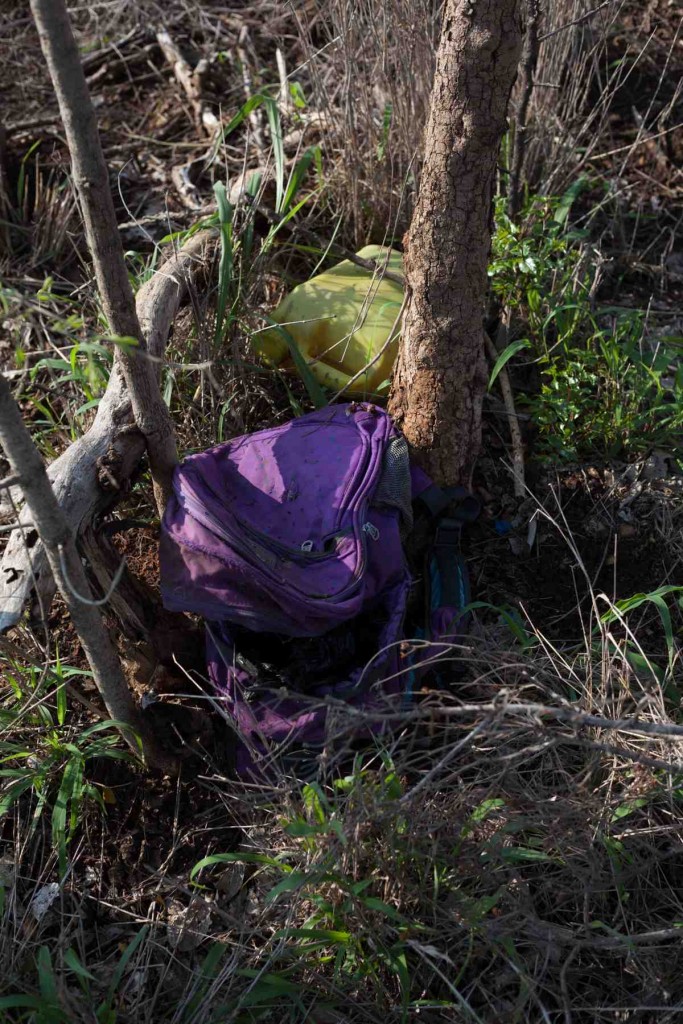
Bags left by poachers in Sabie, close to the Kruger fence. The yellow one contained muti, which poachers believe makes them invisible to rangers
In addition to these hikes, they do car patrols along the roads of the park and aerial patrols. Every day at first and last light, a volunteer pilot flies over the park, looking for tracks, people, breached fences, animal carcasses and anything else that suggests poachers have been there. The pilot is joined by a spotter, who has binoculars and stays in radio contact with rangers on the ground. If they see something from the plane, they tell the rangers to check it out.
I joined one of these morning flights. I was impressed when the pilot spotted a dead tree full of vultures and correctly guessed that an animal carcass was nearby. From the air we saw what looked like a dead rhino lying in the grass. On a second pass we saw that it was a dead buffalo.
The spotter told the rangers, who otherwise might have seen the vultures from a distance and walked over to check it out. This way, they saved their time and energy for more important things, like tracking the few remaining rhinos still in the park.
Whenever we saw a rhino from the plane, the IAPF spotter plotted its location on a map and shared the location with the rangers. In addition to searching for poachers, the rangers also spend their days simply following rhinos around the park – from a safe distance – keeping tabs on their movements. This gives the IAPF a quick response time in case gunshots ring out unexpectedly.
The tight ship IAPF runs at Sabie seems to pay off, buy why does the rhino’s future still look so grim?
Simply put, these outfits are exceptions in a world where many conservation organisations don’t cooperate enough (there are more than 440 separately registered rhino conservation organisations in South Africa alone, all of them with separated resources, money and information), where vast levels of corruption halts progress, where distrust harms relationships between parks and locals, and overwhelming levels of poverty force people to poach.
On the black market rhino horn can fetch prices higher than cocaine, gold and platinum. It’s no wonder that many people want a slice of that pie. They live in a poor country where being lucky enough to have a stable job is still no guarantee that you’ll make enough money to provide for your family. Even if you’re a police officer or a security force member, minimum wage is still just over 3,000 meticais per month, or US$60.
A 2014 report from the US State Department, titled Poaching rhino horn in South Africa and Mozambique: Community and expert views from the trenches, took a comprehensive look at the key factors behind poaching in rural Mozambique and South Africa. Economic incentives are listed as one of the most important ones.
Locally available jobs, “like farming, animal husbandry, selling charcoal, or irregular work in neighbouring cities, simply cannot compare with ‘the gold in the horn’,” according to the report. It goes on to quote several locals from poaching communities on both sides of the border, including Massingir.
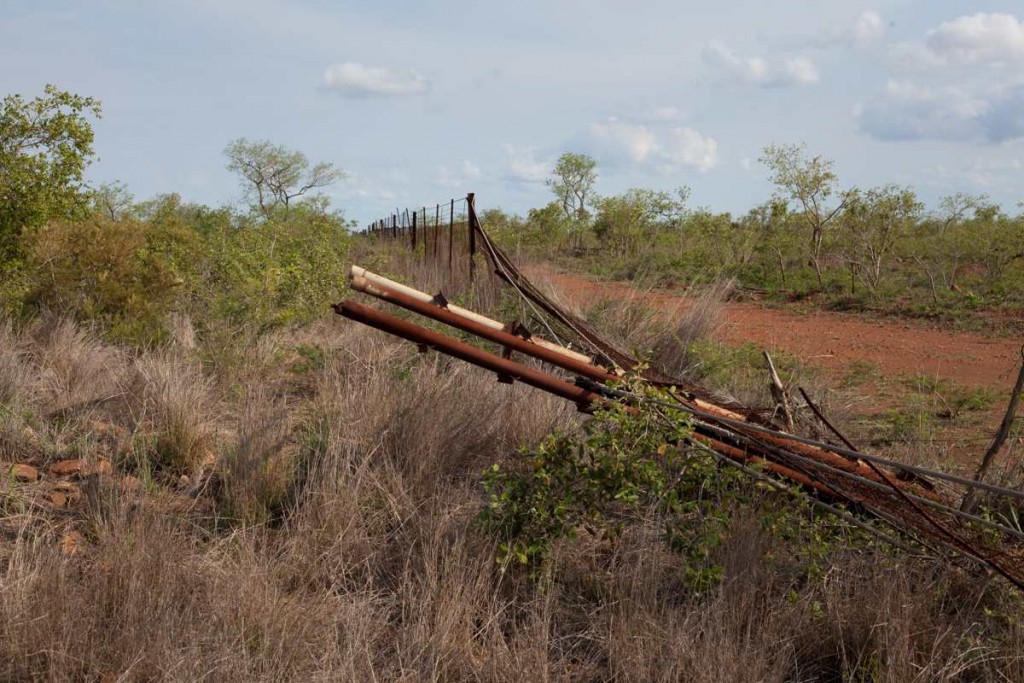
The border fence between Sabie Game Park and the Kruger, home to about 80% of the world’s remaining rhinos
An unemployed man from Kabok, a town close to Massingir, was quoted on the connection between poverty, unemployment and poaching. It is emblematic of views held by many people in these communities: “If we had jobs, we wouldn’t even be thinking of poaching, because when you are working, you get home tired, take a bath, eat and go to sleep. Come payday and you are able to put food on the table.” Many others echo this view, which supports the fact that poverty is a huge contributing factor.
Add to that a level of cynicism, and you can see how hard it is to unite a community around rhino conservation. The people I spoke to said many locals in Mozambique simply don’t care if rhinos go extinct: they don’t see rhinos as a benefit to them, only to the parks and wealthy people whose business depends these animals. To many poor locals it simply doesn’t matter if rhinos go extinct: if they can make big money from the rhinos by taking their horns, all the better for them.
One young man quoted in the report crystallised this view when he said: “We don’t care about xibanjane [local slang for “going for the horn”], whether it continues or not, unless if the park changes its attitude because what kind of neighbours are they that we can’t even get water to drink from the park. Xibanjane can continue, we don’t care, it doesn’t change our lives.” His quote touches on the deep level of distrust that exists between locals and the parks.
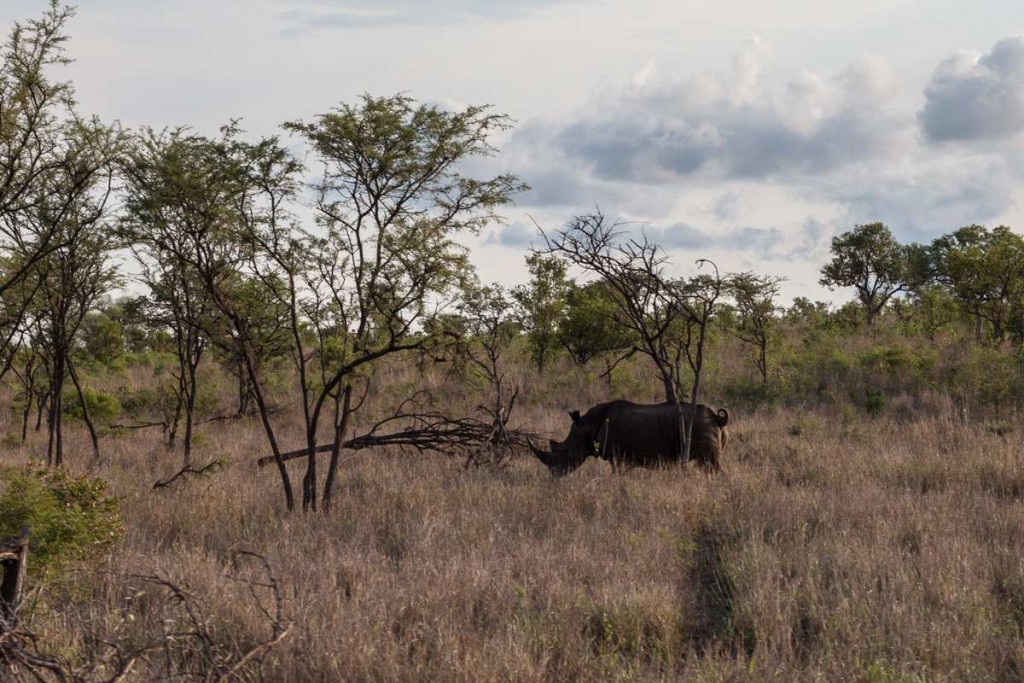
One of the few remaining rhinos left in Mozambique. The IAPF has clamped down on the perimeter security at Sabie Game Park
Moral issue
It became clear to me that this is one of the biggest impediments to successful rhino conservation: park stewards and rangers don’t trust locals because they have experienced local employees giving information to poachers in exchange for money.
In turn, locals don’t trust the parks because of a deep-seated sense that rhinos are more important to them than people. In many instances, locals who make their living from cattle herding and animal husbandry receive no compensation when wildlife kill their animals or trample their crops. Moreover, resettlement projects to move those who live inside the parks have created a lot of anger and frustration, where locals have either refused to move, or moved back into the park later on.
These conflicts will continue to complicate rhino conservation for quite some time. I asked everyone I met in Mozambique if they were hopeful about saving the rhino from extinction. The overwhelming answer was, sadly, “No.”
One of the anti-poaching team members in Sabie expressed dismay over how little progress was being made. “I don’t think we can stop it. All we can do is slow it down,” he said. “But it’s a moral issue. We continue anyway, because it’s the right thing to do.”
Martin Totland wrote his Master’s thesis on rhino poaching in Mozambique for the UC Berkeley Graduate School of Journalism. This investigation was produced under the mentorship programme of Oxpeckers Investigative Environmental Journalism.
Related investigations:
• Kruger’s rhino poaching highway: Mozambican poachers use sugar cane fields to sneak into the Kruger National Park
• The Chinese ivory-smugglers in Mozambique: Who are the Chinese citizens smuggling ivory out of Africa, and how are they doing it? Huang Hongxiang went to Mozambique to investigate
